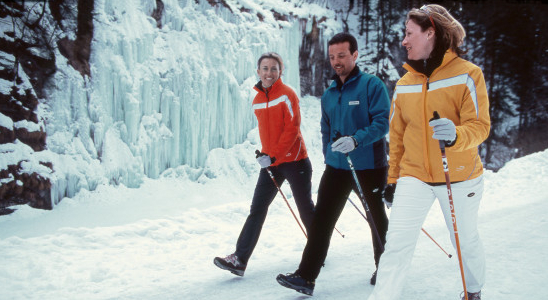I am so not used to this new Vancouver icy weather. I have hit the deck a few times this season, which has lead to some unexpected injuries. Do you have any tips for walking on ice to keep us safe this winter?
This winter we have had an extra bout of ice and snow which has made for some exaggerated arm swings and many close calls. Some of you may have experienced a slip or fall resulting in straining muscles you didn’t even know you had. Falls are the leading cause of injury among older Canadians and the icy conditions have made it challenging for people of all ages. Here are some tips and advice for walking on ice to help keep you safe.
1. Proper footwear
Having proper footwear is essential because shoes are the main interface between you and the slippery ice. To select appropriate shoes, begin by checking the soles for large treads or raised designs which provide the best traction on ice. If your shoes have been worn smooth and it is difficult to feel or see the patterns on the soles it may be time to consider a new pair of winter footwear. Rubber soles are also recommended over plastic as rubber increases the traction between your shoe and the ground. Lastly, find a shoe that fits well and cups your heel as this will stop your foot from rotating inside the shoe, providing a more stable base when transferring your weight.
2. Microspikes or YakTrax
Outdoor stores including MEC carry varying types of micospikes that you put on over your winter shoes. They will provide added traction for walking, hiking, and shoveling snow. They are easy to use and will improve your traction in both ice and snow. Just remember to take them off when you come inside on smooth floors!
3. Wear warm attire
Wearing warm clothes in the winter can help protect you on the ice in a few ways. First, wearing gloves allows you to comfortably keep your hands outside your pockets, so that you can quickly use your arms for balance if needed. Second, many warm layers will help to cushion your fall if you do slip. Pick your brightest winter clothes to help drivers spot you when you’re crossing the road.
4. Stay Active
Maintaining a consistent exercise routine has been shown to reduce the risk of falls, both indoors and outdoors. Staying physically active helps keep your muscles strong and flexible which is beneficial when they have to respond to challenging conditions. Exercise like Pilates or Tai Chi can improve core strength and balance, which helps you control your body position on unstable surfaces.
5. Walking technique
Now we’ve covered how to prepare for walking in the snow and ice now how do we actually do it? First of all look for the best path and go slowly. Walk with a slightly wider than normal stance to increase your base of support. Next, put your whole foot down at once and take even, short steps. We have a tendency to keep the full weight off our feet when we are cautious. This works against us in that we need to put our weight through our good winter shoes for the traction to work. When possible use railings for additional support. Take extra care when you are getting in and out of vehicle and use the vehicle to steady you. If using stairs outside, apply the same principles as for walking and take them one step at a time. Finally, if you do end up falling, tuck your chin to your chest to protect your head from hitting the ground.
6. Walking poles
Consider using poles to give you a much larger base of support, which will help you keep your balance and allow for more points of contact with the ice.
If you don’t want to risk the conditions outside, try to stay active by finding indoor walking routes such as in shopping malls, or complete a home exercise routine!



